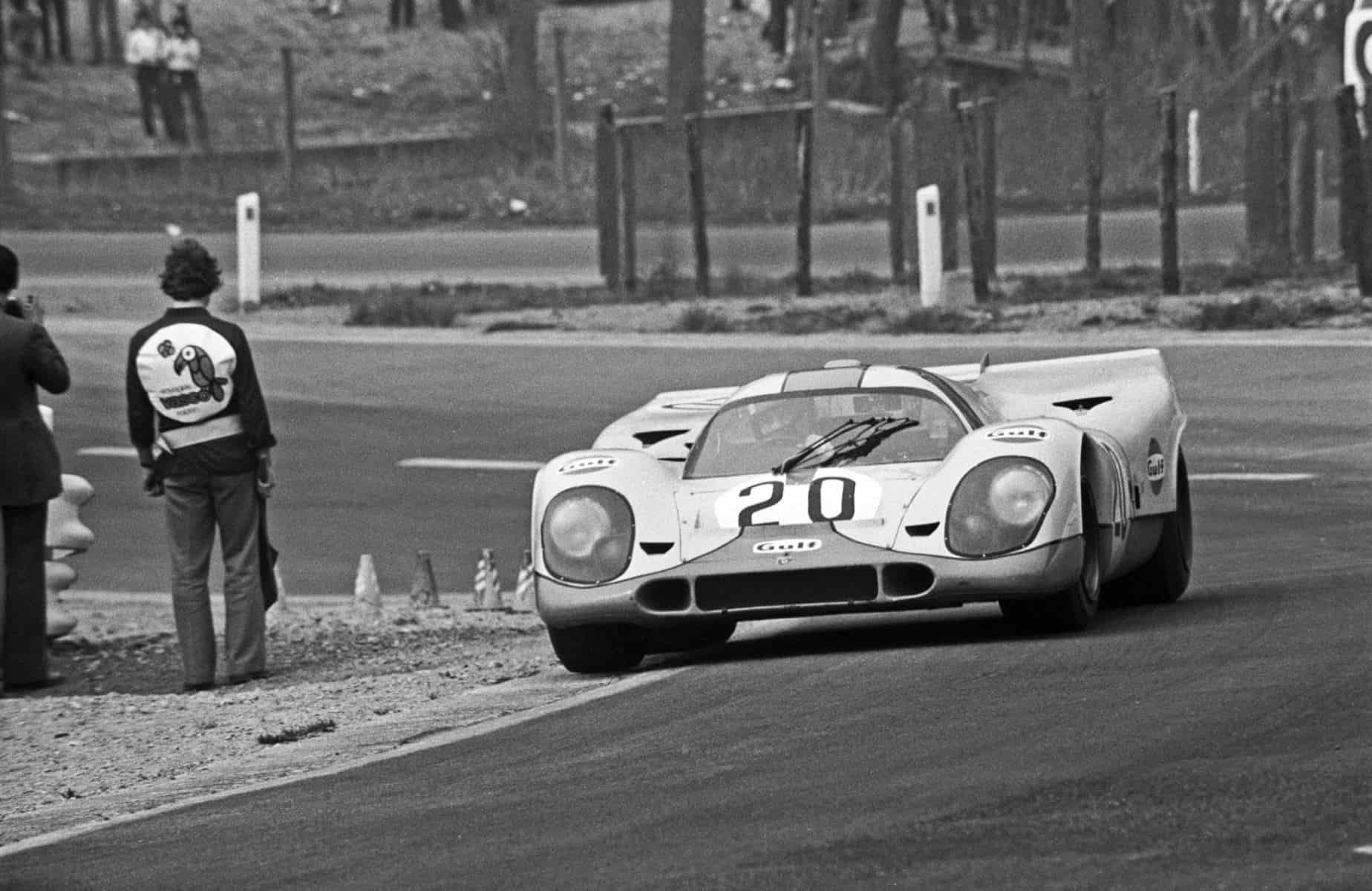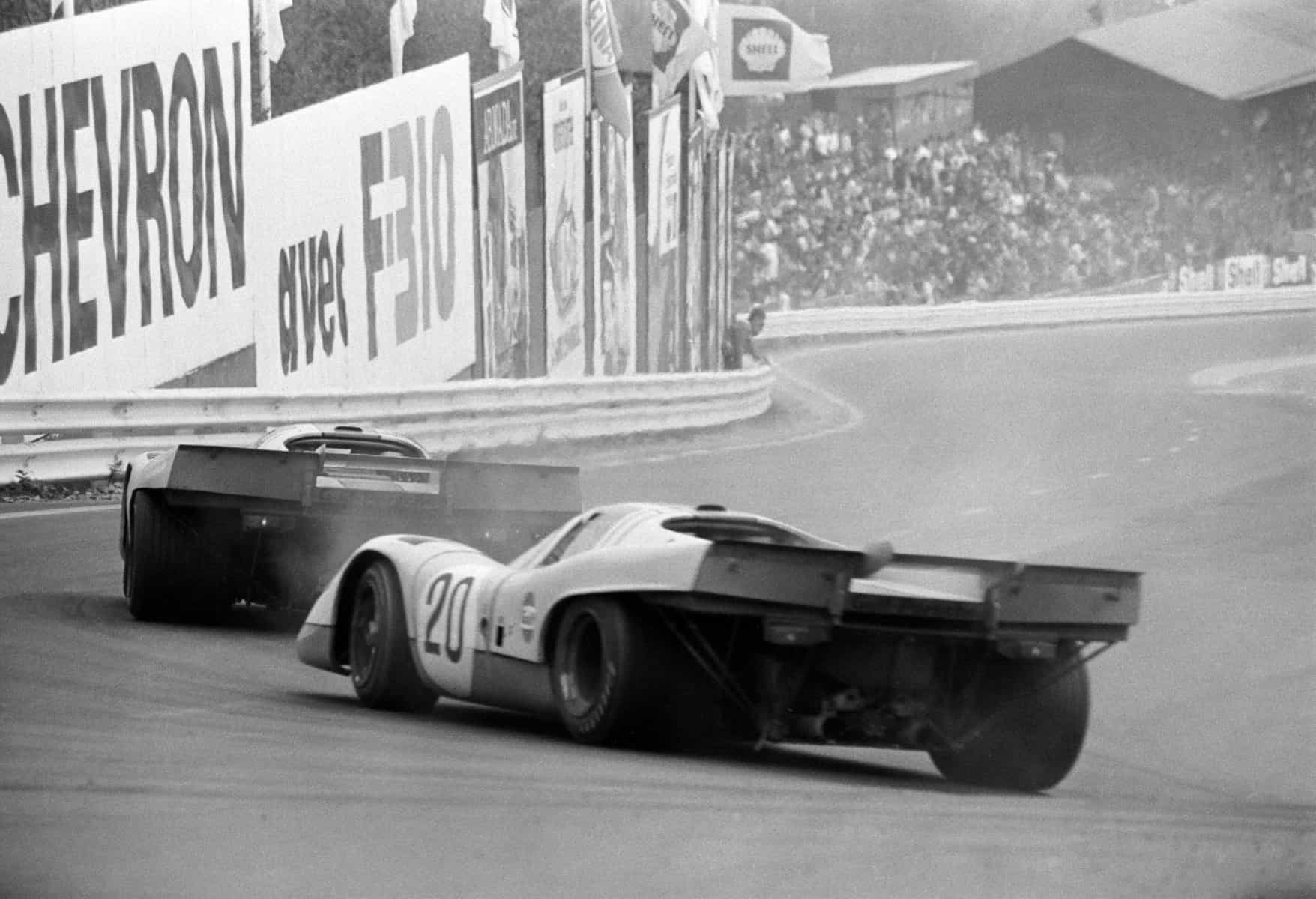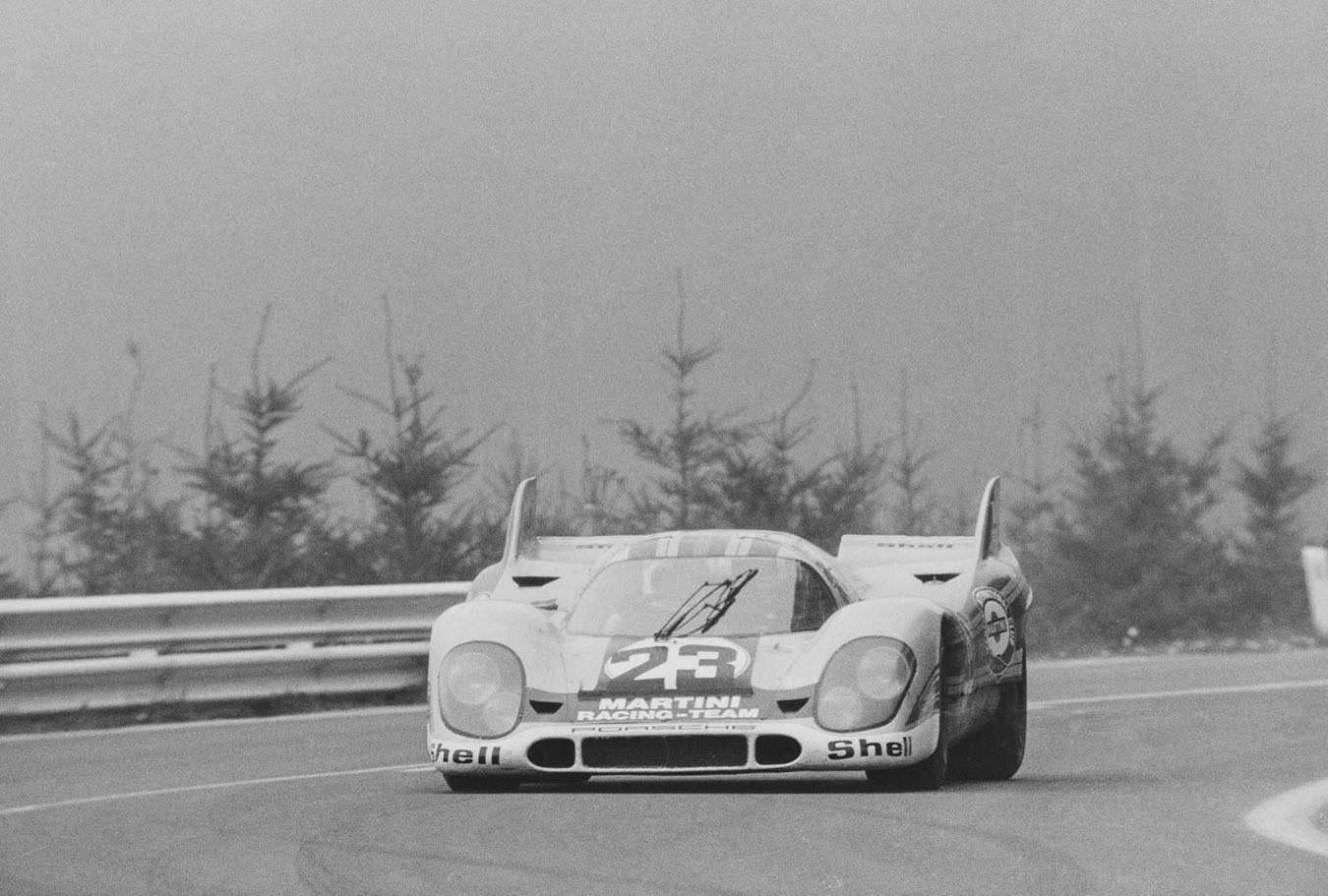1971 Spa 1000Kms
Remembering the fastest sports car race ever, 50 years later
BY: JAY GILLOTTI
Belgium’s Spa-Francorchamps circuit was and remains a daunting and rewarding place for the best drivers in the world. Fifty years ago, on the original public road circuit, average lap speeds for Formula 1 as well as Group 5 sports cars routinely reached 150 mph. In the 1970 edition of the 1000Km race, the winning Gulf-Porsche 917 driven by Jo Siffert and Brian Redman had set a record by averaging 149.42 mph over the entire race distance. Gulf team rivals Siffert and Pedro Rodriguez had famously touched fenders entering Eau Rouge and risked knocking each other off the track.
Although 1971 would be the last season of eligibility for the 917 in the World Sportscar Championship, Porsche continued to develop and improve the cars. One innovation, meant to reduce drag for the short tail 917K without affecting high-speed stability, was the addition of fins to the tail. The fin tails had been used at the previous race at Monza to good effect (Gulf-Porsches finishing first and second). At Spa, the JW Automotive Engineering-Gulf team judged their internally-developed, higher downforce “aerofoil” tail was the better choice for the high speed sweepers at Spa. The adjustable aerofoil sat at the rear of the valley in the 917’s tail.
Spa would also be the third race for the newest version of Porsche’s air-cooled, 180-degree V12, now bored out to 4.99 liters from the previous 4.907 and within a hair of the 5-liter capacity limit. The new engine increased horsepower and torque thanks also to Nikasil (nickel-silicon-carbide) coated cylinder liners. High speed refueling would be in play and helped with a record-setting performance. Porsche and Gulf had been pushed to pressure-fed refueling by Team Penske, who used it for their Ferrari 512M at Daytona and Sebring. JWAE had also developed pressure-fed oil replenishment for the 917 to speed the pit stops. The partially oil-cooled 917 consumed oil at a rate requiring replenishment twice during the Spa race. The team used a small pressurized tank wheeled on a hand cart.
The 1971 race weekend conflicted with the non-Championship International Trophy race for Formula 1 at Silverstone. As a result, Rodriguez and Siffert had to split their time between Belgium and England, the race at Silverstone being run Saturday and the race at Spa set for Sunday. Siffert’s co-driver, Derek Bell, claimed pole position in Siffert’s absence with a lap above 160 mph average speed. The time, 3:16, was three seconds faster than teammate Rodriguez, set before leaving for England. Vic Elford was second fastest in his Martini 917, driving with Gérard Larrousse in the Sebring-winning Chassis 020. Bell confirmed to author Glen Smale in Porsche 917 – The Complete Photographic History the comments from Siffert and Rodriguez after they arrived back at Spa from England: “Pedro and Jo came up and said ‘Fantastic driving!’ Then Pedro said ‘I think it is time you drove with me, Derek.’”
In addition to the two Martini Team 917s, opposition to the Gulf-Porsches came from the Ferrari factory’s new 312PB, driven by Jacky Ickx and Clay Regazzoni, continuing a development program for the 1972 championship. There were also three privately-entered Ferrari 512s, two privateer 917s and a lone Alfa Romeo T33/3 from Autodelta.
On May 9, 1971, the cars powered down the hill to Eau Rouge from the start line. Similar to the previous year’s race, the track was damp but starting to dry. Some teams elected to start on wet weather tires, but Siffert, Rodriguez and team manager David Yorke agreed to start on dry weather intermediates. Siffert led up the hill past Eau Rouge and stayed with Rodriguez all during the first stint. Vic Elford stopped for dry tires at the end of lap one while the Gulf 917s ran away from the field. Rodriguez and Siffert exchanged the lap record, with Pedro setting it finally with the fastest lap at 162.08 mph. JWAE timekeepers recorded it for Rodriguez at 3:13.6 – almost three seconds faster than Bell’s pole time! Official timing for the lap was 3:14.6.
The lead drivers did three stints, co-drivers just two at Spa, so there was only one driver change. After the changeover, slightly better fuel mileage and pit stop times gave Jackie Oliver a 23 second lead over Bell. But Derek closed up to within nine seconds during his first stint. There was only one pit stop remaining in this high speed duel.
Bell stated to Glen Smale that Oliver may have run a red light on the last fuel stop: “When it came to the (last) pit stop he went in after me. I came out and did a ‘blitzing’ lap, but he ignored the red light at the end of the pit lane and came out in front of me.” Derek drove the last stint right on Oliver’s tail, hoping Jackie might make a mistake. Team manager David Yorke held out a pit board calling for the drivers to hold position. However, Jo Siffert tried to signal Derek to pass. In Michael Cotton’s Blue & Orange, Bell described it this way: “David Yorke was holding out a board to hold position (Rod – Sif) but further down the pit lane Seppi was waving at me to go faster, to pass, if only I could!”
Had Oliver made any sort of mistake or bobble, Bell would have passed but in the end, it was second place for Bell with his nose right on the tail of the other Gulf car, Oliver collecting the historic win. The race average speed was the fastest ever for a sports car race, setting a record that is unlikely ever to be broken given the configuration of modern circuits (including the revised Spa-Francorchamps layout). It boggles the mind to think of averaging 154.765 mph (249.069 kph) for 1000 kilometers including the pits stops! Time of the race, per JWAE Chief Engineer John Horsman’s race data sheet was 4 hours, 1 minute, 9.7 seconds, for the distance roughly from Portland, Oregon, to San Francisco.
Horsman noted that the pits stops were extremely quick and with only one driver change, the amount of time spent in the pits was minimal. The final fuel stop was timed to only eight seconds as that was the amount of fuel needed to finish. With no tire changes the cars were stationary less than a minute and a half during the race. Horsman also noted that the cars were using top gear (fourth) for eighty-seven percent of the laps at Spa, including the entire run from the exit of Les Combes all the way back to the hairpin at La Source. Maximum speed on the Masta straight was estimated at 218 mph.
Elford’s Martini 917 failed to finish due to engine problems and Chassis 019, driven by Helmut Marko and Gijs van Lennep just weeks before winning Le Mans, was stopped by a fuel leak. The Ferrari factory 312PB held a solid third place until colliding with a slower car. The Alfa T33/3 driven by Henri Pescarolo and Andrea De Adamich finished in third place, four laps down to the Gulf-Porsches.
In 1973, Jacky Ickx re-set the Spa lap record, putting his Ferrari 312PB on the pole while Henri Pescarolo’s fastest lap in the Matra was also slightly faster than Pedro Rodriguez’ 1971 record.
Writing in Motor Sport, Denis Jenkinson had the last word on the historic 1971 event: “JW Automotive had given a truly outstanding demonstration of long distance racing with perfectly prepared cars that did not suffer from a single fault, team control and race running that was an example to all, and pit work by the mechanics that was perfection at every stop.”
The winning 917, Chassis 035 renumbered 015, later became the Weissach “Taxi,” used for giving VIP rides around the Porsche test track. Restored by Porsche Motorsport North America in 2015, to its 1971 Spa livery, it remains in the Porsche Museum collection. The second place car, Chassis 029 renumbered 014, is the other Gulf-Porsche 917 in the Museum collection (wearing a “fin” tail). The Martini team’s Chassis 019 was acquired by Vasek Polak in 1972 and now resides in the Miles Collier Collections at Revs Institute. The 1971 Spa 1000Kms was its last race and, amazingly, it even retains the paint from that event. Chassis 019 is widely recognized as the most original surviving 917 and is kept in running condition. All three cars serve as fitting reminders for museum visitors and exhibition attendees of the celebrated, high-speed 917 era.
Jay Gillotti has written for publications such as the Porsche Club’s Panorama, Vintage Motorsport, Forza Magazine and the International Motor Racing Research Center blog. His book, Gulf 917, is a chassis-by-chassis history of the Porsche 917s raced by JW Automotive Engineering, available from Dalton Watson Fine Books.
Top Photo: Porsche Archive.








